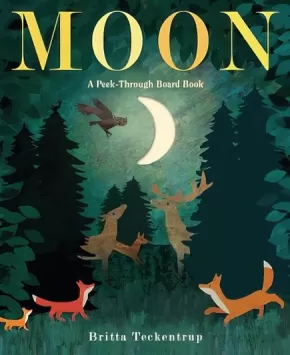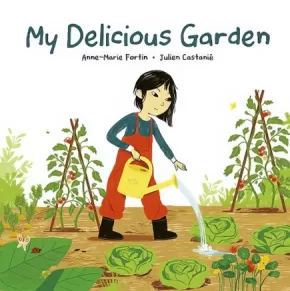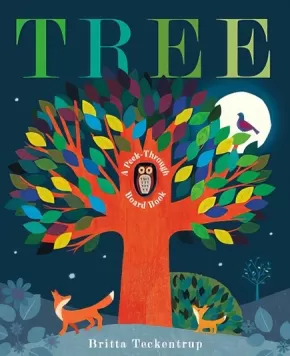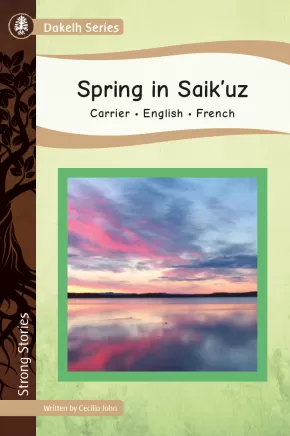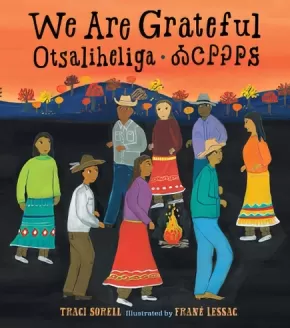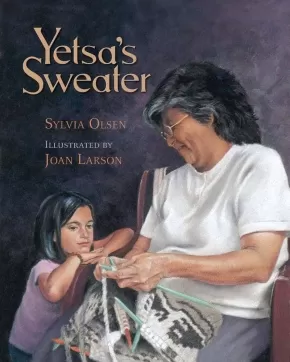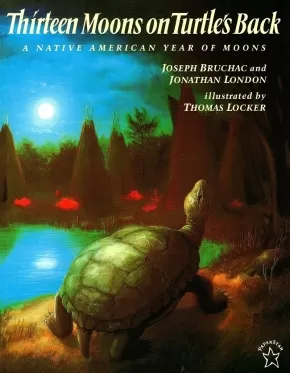
Spring
16
-
30
of
30 Results;
Sort By
Go To
of 2
Moon: A Peek-Through Board Book
$13.99
Artists:
Format:
Board Book
Grade Levels: Preschool;
ISBN / Barcode: 9780593372395
Synopsis:
Synopsis:
From the popular series that launched with Tree: A Peek-Through Picture Book comes a book with peek-through holes that show the moon's different phases with each turn of the page.
Over deserts and forests, Arctic tundra and tropical beaches, the moon shines down on creatures around the world. Children will love discovering how it changes from day to day as the lunar cycle is shown through clever peek-through holes, each revealing the moon in a different size and shape.
It's the perfect light nonfiction book for young stargazers—and an ideal bedtime book, ending with a giant moon hovering over a sleepy town hunkered down for bed.
Educator Information
For ages 3 and under.
Concepts: Seasons, Science, Nature, Astronomy.
Additional Information
26 pages | 6.13" x 7.56" | Board book
My Delicious Garden
$18.95
Artists:
Format:
Hardcover
ISBN / Barcode: 9781771474689
Synopsis:
Synopsis:
A girl lovingly tends to her garden through the seasons.
In the depths of winter, one young girl is already dreaming of planting her very own vegetable garden. In January, she sketches out the rows of lettuce, the trellis for the peas, and a large plot for the tomatoes while she waits for warmer weather. March is time for sowing, and April gives way to the first leaves of her seedlings.
As the seasons change from spring to summer, she (with the help of her moms) spreads compost and turns up the soil to finally plant her veggies into the earth. As the months go by, she lovingly weeds, waters, and cares for her garden until it’s time to harvest a bounty big enough to share with all their friends! My Delicious Garden celebrates the joy of growing food from seed and is a cozy exploration of the connections between nature, food, and community.
Reviews
"The unique monthly focus is an interesting and helpful take on gardening; readers will learn about different types of vegetables and flowers equally. Whether there is a garden at school or not, this is a charming addition to the shelves and could be adapted to a very early science lesson for preschoolers, too." — School Library Journal
"All children will be inspired to grow their own gardens, and those children who live in urban environments will understand and appreciate the work, time, and patience, not to mention the joy and sense of accomplishment, it takes to maintain a garden." — School Library Connection
Educator Information
Recommended for ages 4 to 8.
Keywords and Themes: Gardening, Science, Nature, Cooking, Food, Outdoor Activities, Outdoor Learning
Additional Information
24 pages | 9.00" x 9.00" | Hardcover
Tree: A Peek-Through Board Book
$13.99
Artists:
Format:
Board Book
Grade Levels: Preschool;
ISBN / Barcode: 9780593181775
Synopsis:
Synopsis:
A peek-through board book with elaborate die-cuts on each page showing a tree and its many inhabitants throughout the four seasons.
Through a hole in the book's cover, an owl invites you inside to meet a majestic tree and all its forest inhabitants during the changing seasons. With clever die-cuts throughout, each sturdy page reveals a new set of animals playing and living in the tree--baby bears frolicking in the spring, bees buzzing around apples in the summer, squirrels storing nuts in the fall, and finally the lone owl keeping warm during the winter chill, until another year begins. . . .
Children will love seeing a new set of animals appear as each page is turned, and along the way they'll learn about the seasons and how a forest and its inhabitants change throughout the year.
Educator Information
For ages 3 and under.
Concepts: Seasons, Science, Nature, Animals.
Additional Information
26 pages | 6.13" x 7.50" | Board book
Bebikaan-ezhiwebiziwinan Nimkii: The Adventures of Nimkii
$30.00
Artists:
● Butzin Rachel (Indigenous;)
Format:
Hardcover
Text Content Territories:
Indigenous American; Native American; Anishinaabeg; Ojibwe (Chippewa); Indigenous Canadian; First Nations; Anishinaabeg; Ojibway;
ISBN / Barcode: 9781736551912
Synopsis:
Synopsis:
In this beautifully illustrated children’s book, readers will experience the world in a new way as they see the seasons through the joyful eyes of Nimkii, a fun, nature-loving dog who will teach them a whole new language: Ojibwemowin, a language spoken by the indigenous tribes in parts of Michigan, Ontario, northern Minnesota and Wisconsin, and Alberta.
Whether hunting for maple trees in the fall, playing in the snow in the winter, enjoying the spring showers, or swimming in the summer, Nimkii seeks out activities that allow her to enjoy her natural surroundings. Fun and inspiring, this bilingual book helps children and adults communicate in new ways while exploring different elements of culture.
Educator Information
Children's Literature
Dual-language: English and Ojibwemowin
Translated by Margaret Noodin, of the Pine Marten Clan.
Additional Information
38 pages | 11.00" x 8.50" | Hardcover
Mii maanda ezhi-gkendmaanh / This Is How I Know
$19.99
Format:
Hardcover
Text Content Territories:
Indigenous Canadian; First Nations; Anishinaabeg;
ISBN / Barcode: 9781773063263
Synopsis:
Synopsis:
Niibing, dgwaagig, bboong, mnookmig dbaadjigaade maanpii mzin'igning / A Book about the Seasons.
An Anishinaabe child and her grandmother explore the natural wonders of each season in this lyrical, bilingual story-poem.
In this lyrical story-poem, written in Anishinaabemowin and English, a child and grandmother explore their surroundings, taking pleasure in the familiar sights that each new season brings.
We accompany them through warm summer days full of wildflowers, bees and blueberries, then fall, when bears feast before hibernation and forest mushrooms are ripe for harvest. Winter mornings begin in darkness as deer, mice and other animals search for food, while spring brings green shoots poking through melting snow and the chirping of peepers.
Brittany Luby and Joshua Mangeshig Pawis-Steckley have created a book inspired by childhood memories of time spent with Knowledge Keepers, observing and living in relationship with the natural world in the place they call home — the northern reaches of Anishinaabewaking, around the Great Lakes.
Alvin Ted Corbiere and Alan Corbiere, father and son, are the Anishinaabe translators of this work.
Awards
- 2022 Indigenous Voices Award for a published work in an Indigenous language
Educator Information
Recommended for ages 3 to 7.
Correlates to the Common Core State Standards in English Language Arts:
CCSS.ELA-LITERACY.RL.2.1
Ask and answer such questions as who, what, where, when, why, and how to demonstrate understanding of key details in a text.
CCSS.ELA-LITERACY.RL.2.2
Recount stories, including fables and folktales from diverse cultures, and determine their central message, lesson, or moral.
CCSS.ELA-LITERACY.RL.K.6
With prompting and support, name the author and illustrator of a story and define the role of each in telling the story.
CCSS.ELA-LITERACY.RL.1.4
Identify words and phrases in stories or poems that suggest feelings or appeal to the senses.
CCSS.ELA-LITERACY.RL.2.5
Describe the overall structure of a story, including describing how the beginning introduces the story and the ending concludes the action.
How do you know the seasons? Do you know it's summer when blueberries fall readily and the sand is hot enough to sting? Do you know fall by the red-winged blackbird taking his leave? Take a minute and look around — nature is speaking to us. Changes are happening, and Mother Earth is letting us know at every step of the way. Whether it's the sun's bright morning light, or the white moon sitting high in the sky, there are many ways to know what time of the year it is. All we need to do is stop, look, and listen, because each season tells us a story!
This book is also available in French and Ojibwe: Mii maanda ezhi-gkendmaanh / La Terre me parle: Un livre sur les saisons
Additional Information
44 pages | 8.75" x 8.50"
A Salmon's Sky View
 $18.50
$18.50

Artists:
Format:
Hardcover
ISBN / Barcode: 9781771744461
Synopsis:
Synopsis:
The ink and watercolour illustrations in this book reflect the life cycle of a salmon from the salmon’s point of view looking up from underwater. Silhouette images provide a clue to the seasons and to the predators the salmon encounters throughout its life. The story reminds us how the salmon demonstrates great determination and strength in its long journey from the stream where life begins, to the ocean, and back to its natal stream.
Carol ends the story with a step-by-step instructional guide to create your own ink and watercolour image.
Educator Information
This is the 10th anniversary edition from CSWA Science in Society award-winning author/illustrator Carol McDougall, B. Ed., M.A. Carol is an international educator and conservationist with decades of classroom and fine arts teaching experience. She conducts workshops on using the arts to help make learning creative and engaging.
Recommended Grades: K-5.
Additional Information
32 pages | 11" x 8.5" | ISBN: 9781771744461 | Hardcover
Celebrating Toonik Tyme - Nunavummi Reading Series
$7.95
Artists:
● Tim Mack
Format:
Paperback
Text Content Territories:
Indigenous Canadian; Inuit;
ISBN / Barcode: 9781774501801
Synopsis:
Synopsis:
Toonik Tyme is a lot of fun!
This book describes different things that happen during Toonik Tyme, an annual festival in Iqaluit that celebrates Inuit traditions and the return of spring.
Educator & Series Information
This book is part of the Nunavummi Reading Series, a Nunavut-developed series that supports literacy learning while teaching readers about the people, traditions, and environment of the Canadian Arctic. It is a Level 7 book in the series.
Nunavummi Reading Series books have also been officially levelled using the Fountas & Pinnell Text Level Gradient™ Levelling System. This book's F&P Level is E.
Curriculum Connections: Language and literacy; Indigenous perspectives; Community engagement; History; Heritage
Recommended for ages 5-7.
Additional Information
16 pages | 10.00" x 10.00"
Strong Stories Dakelh: Spring in Saik’uz
 $9.95
$9.95

Format:
Paperback
Text Content Territories:
Indigenous Canadian; First Nations; Dene; Dakelh (Carrier); Saik'uz;
ISBN / Barcode: 9781771743273
Synopsis:
Synopsis:
Come north to Saik’uz (sigh-kuz) located within the Dakelh (dah-kay-lth) Territory and see the trees bud and the birds come back! What is something that you love about spring?
Educator & Series Information
A triple-language resource written in Carrier, English and French.
Recommended for primary students (grades 1-3).
Download a pronunciation guide for the Carrier words in this story: Spring in Saik'uz Pronunciation Guide
Spring in Saik’uz is part of the Strong Stories: Dakelh series. Strong Stories focus on different First Nation territories from across Canada and the United States. These stories reflect the belief that our stories are the roots of our people, our lands and our cultures. It is from our stories that we grow and become strong and proud.
Additional Information
16 pages | 6.00" x 9.00" | ISBN: 9781771743273
We Are Grateful: Otsaliheliga
$21.99
Artists:
Format:
Hardcover
Text Content Territories:
Indigenous American; Native American; Cherokee; Cherokee Nation (Cherokee Nation of Oklahoma);
ISBN / Barcode: 9781580897723
Synopsis:
Synopsis:
The Cherokee community is grateful for blessings and challenges that each season brings. This is modern Native American life as told by an enrolled citizen of the Cherokee Nation.
The word otsaliheliga (oh-jah-LEE-hay-lee-gah) is used by members of the Cherokee Nation to express gratitude. Beginning in the fall with the new year and ending in summer, follow a full Cherokee year of celebrations and experiences. Written by a citizen of the Cherokee Nation, this look at one group of Native Americans is appended with a glossary and the complete Cherokee syllabary, originally created by Sequoyah.
Awards
- 2019 Sibert Honor Book
- NPR's Guide to 2018's Great Reads
- Kirkus Reviews Best Books of 2018
- 2018 Book Launch Award (SCBWI)
Reviews
"According to storyteller Sorell, the Cherokee people always express gratitude for the little things they are given by saying the phrase, "Otsaliheliga," or "we are grateful." Raised in the Cherokee Nation, Sorell intentionally crafts a narrative that simultaneously embraces modernity and a traditional presentation of Cherokee community and way of life. Throughout, the measured text reminds readers that in all things "we say otsaliheliga." Colorful, folk art-style illustrations show Cherokee people during ceremonies, in family gatherings large and small, and outdoors enjoying each of the four seasons, always expressing gratitude. The scenes are contemporary; one shows a father taking care of his children, engaging in a positive parenting role, while another depicts a family seeing off a relative who is leaving for deployment in the military, underscoring that Cherokee people serve their country. Children participate in rites and in family outings with adults, and they also play traditional games such as stickball and plant strawberries, a practice that reminds their people to embrace peace with one another. The variety of skin tones represented in the illustrations likewise depicts a present-day reflection of the diversity that exists within the Cherokee people. Occasional Cherokee words are written in Romanized form, phonetically, in Cherokee characters, and in English—a lovely grace note. A gracious, warm, and loving celebration of community and gratitude. —Kirkus Reviews
"An extended family engages with activities and traditions that express gratitude and carry on Cherokee history and culture, such as stomp dancing at the Great New Moon Ceremony, basket weaving, making corn-husk dolls, and playing stickball. The book underscores the importance of traditions and carrying on a Cherokee way of life while simultaneously incorporating modernity and challenging dated media images of Indigenous people. Here, a father sporting an earring and a topknot minds the children; a family bids goodbye to a clan relative who deploys with the U.S. military. Skin colors range from light to dark, visually underscoring the book’s message of diversity and inclusion. Staying firmly upbeat and idyllic, the cheerful, richly detailed gouache illustrations in bright, saturated colors cycle through the seasons, beginning with the Cherokee New Year in autumn. The text includes several Cherokee words; a line of text in a smaller font along the bottom of the page provides each word as written in the English alphabet, its phonetic pronunciation, the word as written in the Cherokee alphabet, and its definition. A glossary, an author’s note on Cherokee culture, and a complete Cherokee syllabary conclude this attractive and informative book." —Horn Book
"In Cherokee culture, Sorell shares, the expression of gratitude is part of daily life and extends from elaborate celebrations to struggles to ordinary life moments. She organizes her debut picture book by seasons, beginning with the fall, which is a time for collecting foliage for basket making and remembering those who suffered on the Trail of Tears. It also contains the Cherokee New Year and the Great New Moon Ceremony, a celebration of renewal and coming together. Each season section starts with the name of the season in Cherokee, an expression of gratitude for the change in nature, and subsequent pages describing community activities pertinent to that season. Lessac's folkloric illustration in bright gouache colors stands in pleasing contrast to the book’s contemporary feel and setting. The text reads like poetry but has a gentle instructional dimension to it. On many pages, Cherokee words are accompanied by English translations, pronunciation guides, and Cherokee syllabary. Back matter contains relevant explanations and provides good context, and the author's note sets past misrepresentations right" —Booklist
"This informative and authentic introduction to a thriving ancestral and ceremonial way of life is perfect for holiday and family sharing"—School Library Journal
Educator Information
Recommended for ages 3 to 7.
Also available in a boxed set as board books for ages 3 and under: We Are Grateful Otsaliheliga: Seasons (BB - Box Set)
Additional Information
| 32 pages | 9.88" x 10.00" |
Strong Readers Set B: Spring Has Come! (L15)
 $9.00
$9.00

Format:
Paperback
Text Content Territories:
Indigenous Canadian;
Grade Levels: 1;
ISBN / Barcode: 9781771740296
Synopsis:
Synopsis:
Level 15 Back cover book introduction: Spring is the season between winter and summer. The months of spring are March, April and May. What are some activities that you and your family do during the spring months?
Educator & Series Information
Spring Has Come! is part of the Strong Readers: Set B series. Set B is a continuation of Set A. The mixture of fiction and non-fiction books, from levels 11 through 20, expands on frog, bear, eagle, and raven, considering their full lifecycles.
The Strong Readers are a guided/leveled reading series chock full of science, numeracy, social responsibility, language arts and oral language teachings. Strong Readers are rich with scaffolded text features and have beautiful illustrations and photographs. The entire series is interconnected and follows the cultural values of frog, bear, eagle and raven throughout.
Guided Reading Level: 15
This resource is also available in French: Le printemps est arrive !
Additional Information
Book Dimensions: 6in x 9in | Pages: 16 | ISBN: 9781771740296
Strong Readers Set A: Hello Spring! (L2)
 $7.50
$7.50

Format:
Paperback
Grade Levels: Kindergarten;
ISBN / Barcode: 9780987967060
Synopsis:
Synopsis:
Level 2 Back cover book introduction: The animals notice that spring is here so they tell Bear. How do we know when it is spring time?
Educator & Series Information
Hello Spring! is part of the Strong Readers: Set A series. Set A includes a mixture of both fiction and non-fiction books, from levels 1 through 10, based on the appearance, behaviours, and habitats of frog, bear, eagle, and raven. The fictional stories are about frog, bear, eagle, and raven with their friends in their respective habitats.
The Strong Readers are a guided/leveled reading series chock full of science, numeracy, social responsibility, language arts and oral language teachings. Strong Readers are rich with scaffolded text features and have beautiful illustrations and photographs. The entire series is interconnected and follows the cultural values of frog, bear, eagle and raven throughout.
Guided Reading Level: 2
This resource is also available in French: Voici le printemps!
Additional Information
Book Dimensions: 6.5in x 5.5in | Pages: 16 | ISBN: 9780987967060
Strong Readers Set A: Seasons (L10)
 $7.50
$7.50

Format:
Paperback
Text Content Territories:
Indigenous Canadian;
Grade Levels: 1;
ISBN / Barcode: 9781927571309
Synopsis:
Synopsis:
Level 10 Back cover book introduction: There are four seasons during a year, winter, spring, summer and fall. Which season do you think it is on the cover of this book? Which season is it outside right now?
Educator & Series Information
Seasons is part of the Strong Readers: Set A series. Set A includes a mixture of both fiction and non-fiction books, from levels 1 through 10, based on the appearance, behaviours, and habitats of frog, bear, eagle, and raven. The fictional stories are about frog, bear, eagle, and raven with their friends in their respective habitats.
The Strong Readers are a guided/leveled reading series chock full of science, numeracy, social responsibility, language arts and oral language teachings. Strong Readers are rich with scaffolded text features and have beautiful illustrations and photographs. The entire series is interconnected and follows the cultural values of frog, bear, eagle and raven throughout.
Guided Reading Level: 10
This resource is also available in French: Les saisons.
Additional Information
Book Dimensions: 6.5in x 5.5in | Pages: 16 | ISBN: 9781927571309
Yetsa's Sweater
$12.95
Artists:
Format:
Paperback
Text Content Territories:
Indigenous Canadian; First Nations; Salish; Coast Salish; Cowichan;
ISBN / Barcode: 9781550392029
Synopsis:
Synopsis:
On a fresh spring day, young Yetsa, her mother and her grand-mother gather to prepare the sheep fleeces piled in Grandma's yard. As they clean, wash and dry the fleece, laughter and hard work connect the three generations. The reader joins this family in an old, but vibrant tradition: the creation of a Cowichan sweater.
Additional Information
|
Morning On The Lake
$7.99
Artists:
Format:
Paperback
Text Content Territories:
Indigenous Canadian; First Nations; Anishinaabeg; Ojibway;
ISBN / Barcode: 9781550745887
Synopsis:
Synopsis:
A young boy and his grandfather set out in a birchbark canoe early one spring morning. Under the patient and gentle guidance of his grandfather, the boy gradually comes to respect the ways of nature and to understand his own place in the world.
In the first of three linked stories, a young boy and his grandfather set out in a birchbark canoe early one spring morning. Together, they discover the peaceful beauty of the lake. In the second story, the sun rises high in the summer sky as they climb a rocky cliff for a bird's-eye view of the land. And, finally, as an autumn night descends, they venture into the woods. Under the patient and gentle guidance of his grandfather, the boy gradually comes to respect the ways of nature and to understand his own place in the world.
Reviews
"Filled with lessons of love and respect for Mother Earth, this book is packed with many Ojibway cultural references for young readers. Noshen and his grandfather, Mishomis, set off in a birchbark canoe, climb a mountain and stand off a pack of wolves - all in one day. Noshen learns that he is brother to the wolves and need not be afraid of any animal he meets in the woods. Karen Reczuch's illustrations of many culturally-relevant objects like beadwork designs and Mishomis' moccasins make this book something to be treasured." —Aboriginal Voices
"From the first words of Morning on the Lake, it's evident the author has an abundance of love and respect for the force of nature in all its magnificence. And, as we follow the young native protagonist and his grandfather, the call of the wild sounds ever more clear. Early one morning, the boy and his grandfather set off in their canoe and are rewarded with a rare glimpse of a family of loons. Later that day, they climb to the top of a hill and have an encounter with a bald eagle. And in the still night, the boy comes face to face with a pack of wolves. In this boy's traditional world, nature is given very human qualities which can set the heart a-thumping as well as soothe the spirit. Karen Reczuch's tranquil illustrations lovingly portray the relationship between man and his surroundings." —Children's Book News
Educator Information
Recommended for ages 5 to 9.
Additional Information
32 pages | 10.00" x 9.00"
Thirteen Moons On Turtle's Back: A Native American Year Of Moons
$12.49
Format:
Paperback
Text Content Territories:
Indigenous American; Native American;
ISBN / Barcode: 9780698115842
Synopsis:
Synopsis:
To many Native Americans, the 13 cycles of the moon represent the changing seasons and the passage of time. Each moon has its own special name that, while varying among the tribal nations, is consistent with the legend that the 13 scales on Old Turtle's back hold the key to these moons. The authors present 13 poems that take readers through the year, from the "Moon of Popping Trees"--when the "cottonwoods crack with frost"--to the "Big Moon" of the Abenakis. The book's effective design consists of verses in vertical columns at the left of each spread, with the remainder occupied by Locker's ( Family Farm ; Catskill Eagle ) typically lush artwork. His oil paintings are eye-catching in their depth of color reflecting dramatic seasonal changes. Trees, skies and woodland creatures are rendered in vivid hues that combine to produce an enthralling vision. This unusual and intelligent book is an exemplary introduction to Native American culture with its emphasis on the importance of nature.
Additional Infromation
32 pages | 8.00" x 10.25"
Sort By
Go To
of 2

